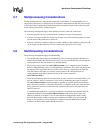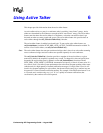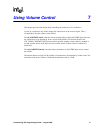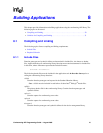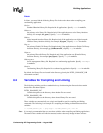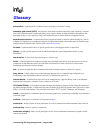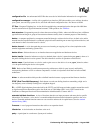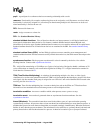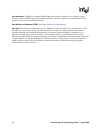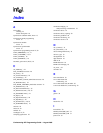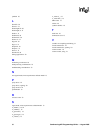
34 Conferencing API Programming Guide — August 2006
configuration file: An unformatted ASCII file that stores device initialization information for an application.
configuration manager: A utility with a graphical user interface (GUI) that enables you to add new boards to
your system, start and stop system service, and work with board configuration data. Also known as DCM.
CT Bus: Computer Telephony bus. A time division multiplexing communications bus that provides 4096 time
slots for transmission of digital information between CT Bus products. See TDM bus.
data structure: Programming term for a data element consisting of fields, where each field may have a different
type definition and length. A group of data structure elements usually share a common purpose or functionality.
device: A computer peripheral or component controlled through a software device driver. An Intel voice and/or
network interface expansion board is considered a physical board containing one or more logical board devices, and
each channel or time slot on the board is a device.
device channel: A voice data path that processes one incoming or outgoing call at a time (equivalent to the
terminal equipment terminating a phone line).
device driver: Software that acts as an interface between an application and hardware devices.
device handle: Numerical reference to a device, obtained when a device is opened using xx_open( ), where xx is
the prefix defining the device to be opened. The device handle is used for all operations on that device.
device name: Literal reference to a device, used to gain access to the device via an xx_open( ) function, where
xx is the prefix defining the device to be opened.
DM3: Refers to Intel Dialogic mediastream processing architecture, which is open, layered, and flexible,
encompassing hardware as well as software components. A whole set of products from Intel are built on DM3
architecture.
driver: A software module which provides a defined interface between a program and the firmware interface.
DTMF (Dual-Tone Multifrequency): Push-button or touch-tone dialing based on transmitting a high- and a
low-frequency tone to identify each digit on a telephone keypad.
E1: A CEPT digital telephony format devised by the CCITT, used in Europe and other countries around the world.
A digital transmission channel that carries data at the rate of 2.048 Mbps (DS-1 level). CEPT stands for the
Conference of European Postal and Telecommunication Administrations. Contrast with T1.
extended attribute functions: A class of functions that take one input parameter and return device-specific
information. For instance, a voice device’s extended attribute function returns information specific to the voice
devices. Extended attribute function names are case-sensitive and must be in capital letters. See also standard
runtime library (SRL).
firmware: A set of program instructions that reside on an expansion board.
idle device: A device that has no functions active on it.
party: A participant in a conference. Synonym of conferee.



